Keyword
GOME.TC.AGG
10 record(s)
Provided by
Type of resources
Available actions
Topics
Keywords
Contact for the resource
Update frequencies
-

The Global Ozone Monitoring Experiment-2 (GOME-2) instrument continues the long-term monitoring of atmospheric trace gas constituents started with GOME / ERS-2 and SCIAMACHY / Envisat. Currently, there are three GOME-2 instruments operating on board EUMETSAT's Meteorological Operational satellites MetOp-A, -B and -C, launched in October 2006, September 2012, and November 2018, respectively. GOME-2 can measure a range of atmospheric trace constituents, with the emphasis on global ozone distributions. Furthermore, cloud properties and intensities of ultraviolet radiation are retrieved. These data are crucial for monitoring the atmospheric composition and the detection of pollutants. DLR generates operational GOME-2 / MetOp level 2 products in the framework of EUMETSAT's Satellite Application Facility on Atmospheric Chemistry Monitoring (AC-SAF). GOME-2 near-real-time products are available already two hours after sensing. OCRA (Optical Cloud Recognition Algorithm) and ROCINN (Retrieval of Cloud Information using Neural Networks) are used for retrieving the following geophysical cloud properties from GOME and GOME-2 data: cloud fraction (cloud cover), cloud-top pressure (cloud-top height), and cloud optical thickness (cloud-top albedo). OCRA is an optical sensor cloud detection algorithm that uses the PMD devices on GOME / GOME-2 to deliver cloud fractions for GOME / GOME-2 scenes. ROCINN takes the OCRA cloud fraction as input and uses a neural network training scheme to invert GOME / GOME-2 reflectivities in and around the O2-A band. VLIDORT [Spurr (2006)] templates of reflectances based on full polarization scattering of light are used to train the neural network. ROCINN retrieves cloud-top pressure and cloud-top albedo. The cloud-top pressure for GOME scenes is derived from the cloud-top height provided by ROCINN and an appropriate pressure profile. For more details please refer to relevant peer-review papers listed on the GOME and GOME-2 documentation pages: https://atmos.eoc.dlr.de/app/docs/
-

The Global Ozone Monitoring Experiment-2 (GOME-2) instrument continues the long-term monitoring of atmospheric trace gas constituents started with GOME / ERS-2 and SCIAMACHY / Envisat. Currently, there are three GOME-2 instruments operating on board EUMETSAT's Meteorological Operational satellites MetOp-A, -B, and -C, launched in October 2006, September 2012, and November 2018, respectively. GOME-2 can measure a range of atmospheric trace constituents, with the emphasis on global ozone distributions. Furthermore, cloud properties and intensities of ultraviolet radiation are retrieved. These data are crucial for monitoring the atmospheric composition and the detection of pollutants. DLR generates operational GOME-2 / MetOp level 2 products in the framework of EUMETSAT's Satellite Application Facility on Atmospheric Chemistry Monitoring (AC-SAF). GOME-2 near-real-time products are available already two hours after sensing. The operational HCHO total column products are generated using the algorithm GDP (GOME Data Processor) version 4.x integrated into the UPAS (Universal Processor for UV / VIS Atmospheric Spectrometers) processor for generating level 2 trace gas and cloud products. For more details please refer to relevant peer-review papers listed on the GOME and GOME-2 documentation pages: https://atmos.eoc.dlr.de/app/docs/
-
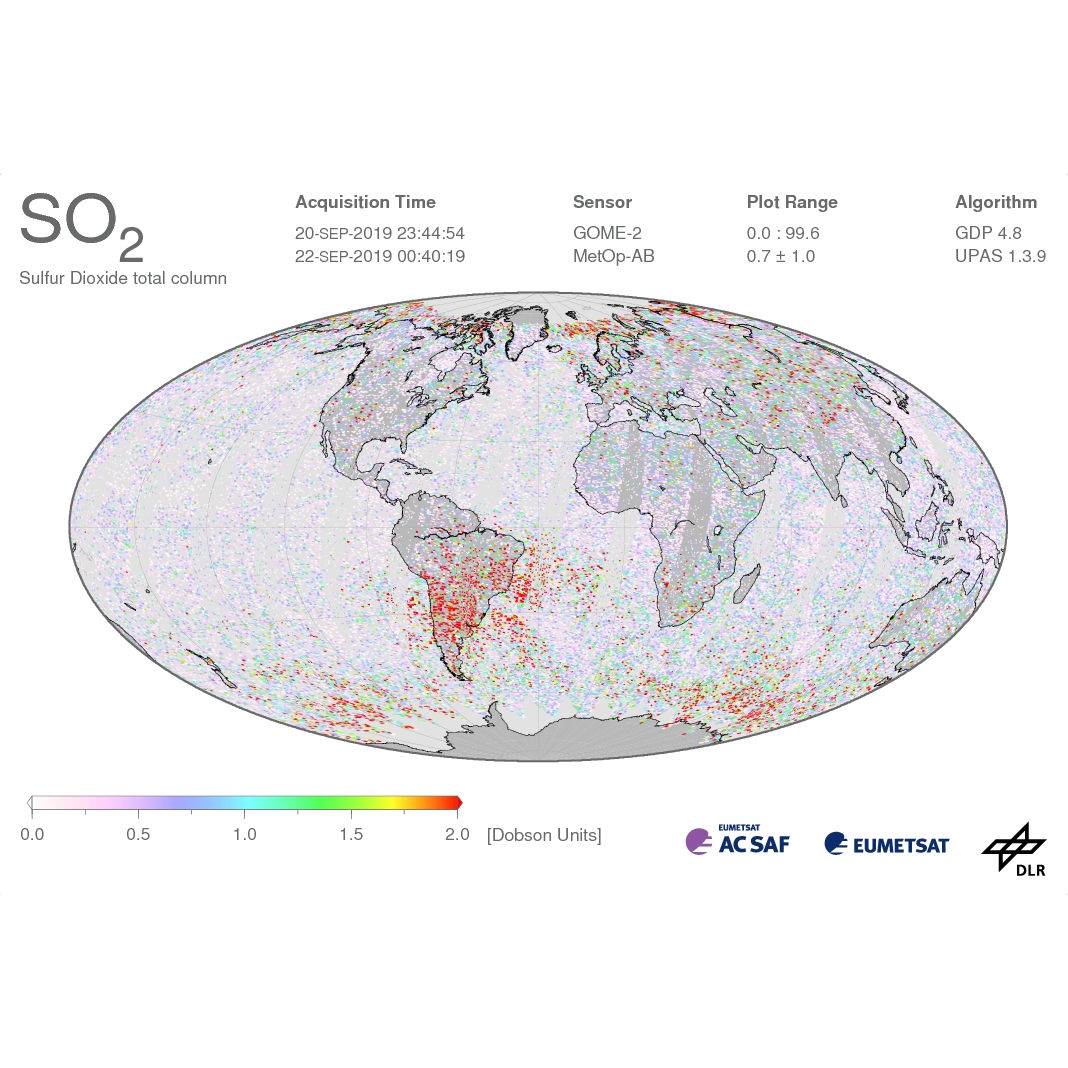
The Global Ozone Monitoring Experiment-2 (GOME-2) instrument continues the long-term monitoring of atmospheric trace gas constituents started with GOME / ERS-2 and SCIAMACHY / Envisat. Currently, there are three GOME-2 instruments operating on board EUMETSAT's Meteorological Operational satellites MetOp-A, -B, and -C, launched in October 2006, September 2012, and November 2018, respectively. GOME-2 can measure a range of atmospheric trace constituents, with the emphasis on global ozone distributions. Furthermore, cloud properties and intensities of ultraviolet radiation are retrieved. These data are crucial for monitoring the atmospheric composition and the detection of pollutants. DLR generates operational GOME-2 / MetOp level 2 products in the framework of EUMETSAT's Satellite Application Facility on Atmospheric Chemistry Monitoring (AC-SAF). GOME-2 near-real-time products are available already two hours after sensing. The operational SO2 total column products are generated using the algorithm GDP (GOME Data Processor) version 4.x integrated into the UPAS (Universal Processor for UV / VIS Atmospheric Spectrometers) processor for generating level 2 trace gas and cloud products. GDP 4.x performs a DOAS fit for SO2 slant column followed by an AMF / VCD computation using a single wavelength. Corrections are applied to the slant column for equatorial offset, interference of SO2 and SO2 absorption, and SZA dependence. For more details please refer to relevant peer-review papers listed on the GOME and GOME-2 documentation pages: https://atmos.eoc.dlr.de/app/docs/
-
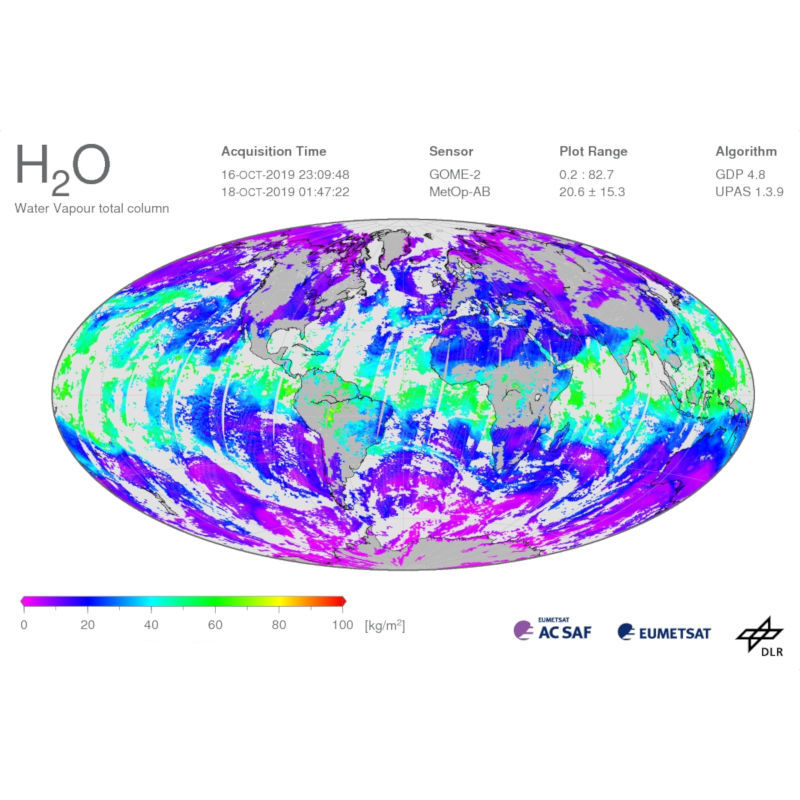
The Global Ozone Monitoring Experiment-2 (GOME-2) instrument continues the long-term monitoring of atmospheric trace gas constituents started with GOME / ERS-2 and SCIAMACHY / Envisat. Currently, there are three GOME-2 instruments operating on board EUMETSAT's Meteorological Operational satellites MetOp-A, -B and -C, launched in October 2006, September 2012, and November 2018, respectively. GOME-2 can measure a range of atmospheric trace constituents, with the emphasis on global ozone distributions. Furthermore, cloud properties and intensities of ultraviolet radiation are retrieved. These data are crucial for monitoring the atmospheric composition and the detection of pollutants. DLR generates operational GOME-2 / MetOp level 2 products in the framework of EUMETSAT's Satellite Application Facility on Atmospheric Chemistry Monitoring (AC-SAF). GOME-2 near-real-time products are available already two hours after sensing. The operational H2O total column products are generated using the algorithm GDP (GOME Data Processor) version 4.x integrated into the UPAS (Universal Processor for UV/VIS Atmospheric Spectrometers) processor for generating level 2 trace gas and cloud products. The total H2O column is retrieved from GOME solar backscattered measurements in the red wavelength region (614-683.2 nm), using the Differential Optical Absorption Spectroscopy (DOAS) method. For more details please refer to relevant peer-review papers listed on the GOME and GOME-2 documentation pages: https://atmos.eoc.dlr.de/app/docs/
-
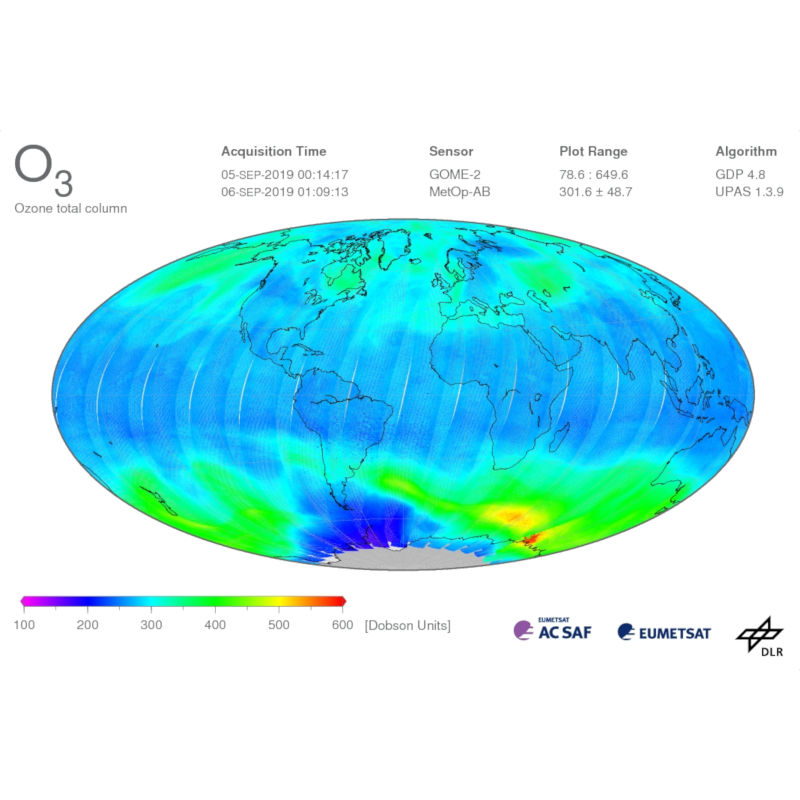
The Global Ozone Monitoring Experiment-2 (GOME-2) instrument continues the long-term monitoring of atmospheric trace gas constituents started with GOME / ERS-2 and SCIAMACHY / Envisat. Currently, there are three GOME-2 instruments operating on board EUMETSAT's Meteorological Operational satellites MetOp-A, -B, and -C, launched in October 2006, September 2012, and November 2018, respectively. GOME-2 can measure a range of atmospheric trace constituents, with the emphasis on global ozone distributions. Furthermore, cloud properties and intensities of ultraviolet radiation are retrieved. These data are crucial for monitoring the atmospheric composition and the detection of pollutants. DLR generates operational GOME-2 / MetOp level 2 products in the framework of EUMETSAT's Satellite Application Facility on Atmospheric Chemistry Monitoring (AC-SAF). GOME-2 near-real-time products are available already two hours after sensing. The operational ozone total column products are generated using the algorithm GDP (GOME Data Processor) version 4.x integrated into the UPAS (Universal Processor for UV / VIS Atmospheric Spectrometers) processor for generating level 2 trace gas and cloud products. The new improved DOAS-style (Differential Optical Absorption Spectroscopy) algorithm called GDOAS, was selected as the basis for GDP version 4.0 in the framework of an ESA ITT. GDP 4.x performs a DOAS fit for ozone slant column and effective temperature followed by an iterative AMF / VCD computation using a single wavelength. For more details please refer to relevant peer-review papers listed on the GOME and GOME-2 documentation pages: https://atmos.eoc.dlr.de/app/docs/
-

The Global Ozone Monitoring Experiment-2 (GOME-2) instrument continues the long-term monitoring of atmospheric trace gas constituents started with GOME / ERS-2 and SCIAMACHY / Envisat. Currently, there are three GOME-2 instruments operating on board EUMETSAT's Meteorological Operational satellites MetOp-A, -B and -C, launched in October 2006, September 2012, and November 2018, respectively. GOME-2 can measure a range of atmospheric trace constituents, with the emphasis on global ozone distributions. Furthermore, cloud properties and intensities of ultraviolet radiation are retrieved. These data are crucial for monitoring the atmospheric composition and the detection of pollutants. DLR generates operational GOME-2 / MetOp level 2 products in the framework of EUMETSAT's Satellite Application Facility on Atmospheric Chemistry Monitoring (AC-SAF). GOME-2 near-real-time products are available already two hours after sensing. The operational BrO (Bromine monoxide) total column products are generated using the algorithm GDP (GOME Data Processor) version 4.x integrated into the UPAS (Universal Processor for UV / VIS Atmospheric Spectrometers) processor for generating level 2 trace gas and cloud products. For more details please refer to https://atmos.eoc.dlr.de/app/missions/gome2
-
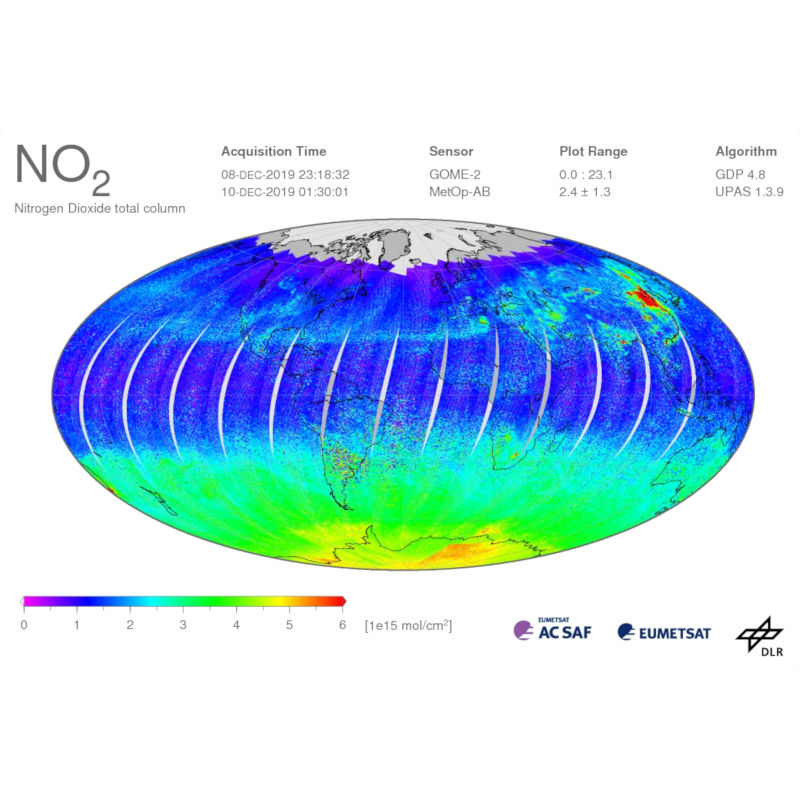
The Global Ozone Monitoring Experiment-2 (GOME-2) instrument continues the long-term monitoring of atmospheric trace gas constituents started with GOME / ERS-2 and SCIAMACHY / Envisat. Currently, there are three GOME-2 instruments operating on board EUMETSAT's Meteorological Operational satellites MetOp-A, -B, and -C, launched in October 2006, September 2012, and November 2018, respectively. GOME-2 can measure a range of atmospheric trace constituents, with the emphasis on global ozone distributions. Furthermore, cloud properties and intensities of ultraviolet radiation are retrieved. These data are crucial for monitoring the atmospheric composition and the detection of pollutants. DLR generates operational GOME-2 / MetOp level 2 products in the framework of EUMETSAT's Satellite Application Facility on Atmospheric Chemistry Monitoring (AC-SAF). GOME-2 near-real-time products are available already two hours after sensing. The operational NO2 total column products are generated using the algorithm GDP (GOME Data Processor) version 4.x integrated into the UPAS (Universal Processor for UV / VIS Atmospheric Spectrometers) processor for generating level 2 trace gas and cloud products. The total NO2 column is retrieved from GOME solar back-scattered measurements in the visible wavelength region (425-450 nm), using the Differential Optical Absorption Spectroscopy (DOAS) method. For more details please refer to relevant peer-review papers listed on the GOME and GOME-2 documentation pages: https://atmos.eoc.dlr.de/app/docs/
-

The Global Ozone Monitoring Experiment-2 (GOME-2) instrument continues the long-term monitoring of atmospheric trace gas constituents started with GOME / ERS-2 and SCIAMACHY / Envisat. Currently, there are three GOME-2 instruments operating on board EUMETSAT's Meteorological Operational satellites MetOp-A, -B and -C, launched in October 2006, September 2012, and November 2018, respectively. GOME-2 can measure a range of atmospheric trace constituents, with the emphasis on global ozone distributions. Furthermore, cloud properties and intensities of ultraviolet radiation are retrieved. These data are crucial for monitoring the atmospheric composition and the detection of pollutants. DLR generates operational GOME-2 / MetOp level 2 products in the framework of EUMETSAT's Satellite Application Facility on Atmospheric Chemistry Monitoring (AC-SAF). GOME-2 near-real-time products are available already two hours after sensing. OCRA (Optical Cloud Recognition Algorithm) and ROCINN (Retrieval of Cloud Information using Neural Networks) are used for retrieving the following geophysical cloud properties from GOME and GOME-2 data: cloud fraction (cloud cover), cloud-top pressure (cloud-top height), and cloud optical thickness (cloud-top albedo). OCRA is an optical sensor cloud detection algorithm that uses the PMD devices on GOME / GOME-2 to deliver cloud fractions for GOME / GOME-2 scenes. ROCINN takes the OCRA cloud fraction as input and uses a neural network training scheme to invert GOME / GOME-2 reflectivities in and around the O2-A band. VLIDORT [Spurr (2006)] templates of reflectances based on full polarization scattering of light are used to train the neural network. ROCINN retrieves cloud-top pressure and cloud-top albedo. The cloud optical thickness is computed using libRadtran [Mayer and Kylling (2005)] radiative transfer simulations taking as input the cloud-top albedo retrieved with ROCINN. For more details please refer to relevant peer-review papers listed on the GOME and GOME-2 documentation pages: https://atmos.eoc.dlr.de/app/docs/
-
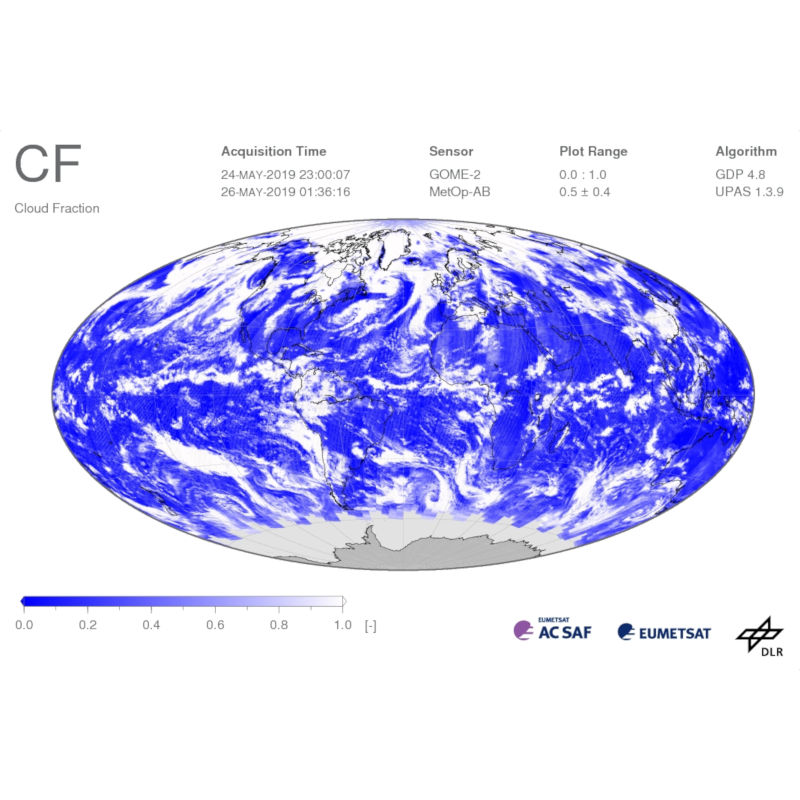
The Global Ozone Monitoring Experiment-2 (GOME-2) instrument continues the long-term monitoring of atmospheric trace gas constituents started with GOME / ERS-2 and SCIAMACHY / Envisat. Currently, there are three GOME-2 instruments operating on board EUMETSAT's Meteorological Operational satellites MetOp-A, -B and -C, launched in October 2006, September 2012, and November 2018, respectively. GOME-2 can measure a range of atmospheric trace constituents, with the emphasis on global ozone distributions. Furthermore, cloud properties and intensities of ultraviolet radiation are retrieved. These data are crucial for monitoring the atmospheric composition and the detection of pollutants. DLR generates operational GOME-2 / MetOp level 2 products in the framework of EUMETSAT's Satellite Application Facility on Atmospheric Chemistry Monitoring (AC-SAF). GOME-2 near-real-time products are available already two hours after sensing. OCRA (Optical Cloud Recognition Algorithm) and ROCINN (Retrieval of Cloud Information using Neural Networks) are used for retrieving the following geophysical cloud properties from GOME and GOME-2 data: cloud fraction (cloud cover), cloud-top pressure (cloud-top height), and cloud optical thickness (cloud-top albedo). OCRA is an optical sensor cloud detection algorithm that uses the PMD devices on GOME / GOME-2 to deliver cloud fractions for GOME / GOME-2 scenes. For more details please refer to relevant peer-review papers listed on the GOME and GOME-2 documentation pages: https://atmos.eoc.dlr.de/app/docs/
-
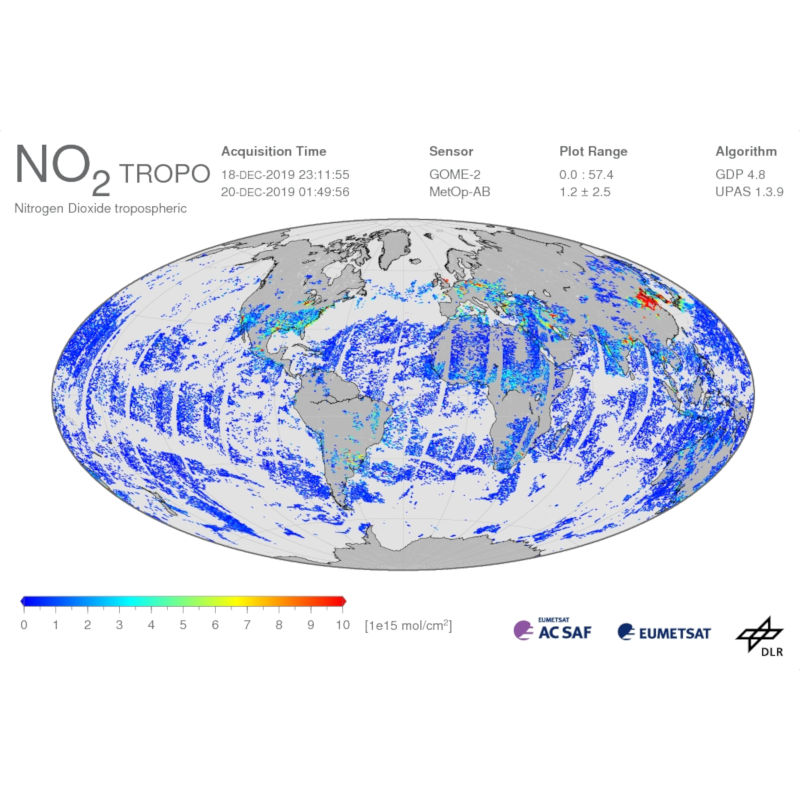
The Global Ozone Monitoring Experiment-2 (GOME-2) instrument continues the long-term monitoring of atmospheric trace gas constituents started with GOME / ERS-2 and SCIAMACHY / Envisat. Currently, there are three GOME-2 instruments operating on board EUMETSAT's Meteorological Operational satellites MetOp-A, -B, and -C, launched in October 2006, September 2012, and November 2018, respectively. GOME-2 can measure a range of atmospheric trace constituents, with the emphasis on global ozone distributions. Furthermore, cloud properties and intensities of ultraviolet radiation are retrieved. These data are crucial for monitoring the atmospheric composition and the detection of pollutants. DLR generates operational GOME-2 / MetOp level 2 products in the framework of EUMETSAT's Satellite Application Facility on Atmospheric Chemistry Monitoring (AC-SAF). GOME-2 near-real-time products are available already two hours after sensing. The operational NO2 total column products are generated using the algorithm GDP (GOME Data Processor) version 4.x integrated into the UPAS (Universal Processor for UV / VIS Atmospheric Spectrometers) processor for generating level 2 trace gas and cloud products. The operational NO2 tropospheric column products are generated using the algorithm GDP (GOME Data Processor) version 4.x for NO2 [Valks et al. (2011)] integrated into the UPAS (Universal Processor for UV / VIS Atmospheric Spectrometers) processor for generating level 2 trace gas and cloud products. The total NO2 column is retrieved from GOME solar back-scattered measurements in the visible wavelength region using the DOAS method. An additional algorithm is applied to derive the tropospheric NO2 column: after subtracting the estimated stratospheric component from the total column, the tropospheric NO2 column is determined using an air mass factor based on monthly climatological NO2 profiles from the MOZART-2 model. For more details please refer to relevant peer-review papers listed on the GOME and GOME-2 documentation pages: https://atmos.eoc.dlr.de/app/docs/
 www.geodatenkatalog.de (S1L)
www.geodatenkatalog.de (S1L)